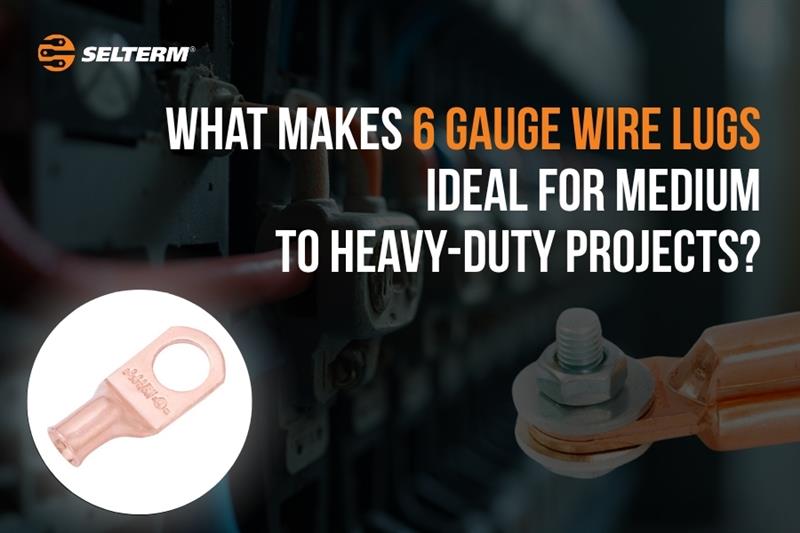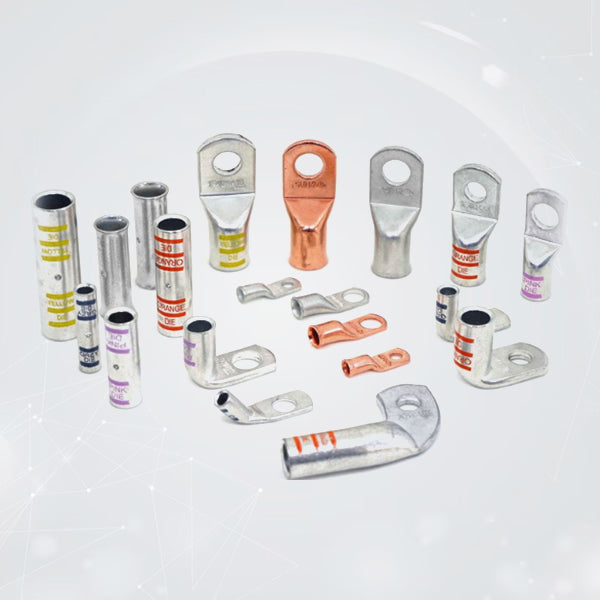
What Makes 6 Gauge Wire Lugs Ideal For Medium To Heavy-Duty Projects?
If you plan to do electrical wiring in high-demand environments such as upgrading your RV battery system, restoring a golf cart, a solar install, or even customizing a car audio system, reliability, conductivity, and corrosion resistance are essential. 6 gauge wire lug is ideal for high-demand applications. They are small but mighty and made for high current without compromising your performance and safety.
In this blog, we’ll explore what makes 6 AWG terminal lug a go-to choice for medium to heavy-duty projects, the applications where they shine, and how to choose the right type for your needs.
What Is A 6 AWG Wire Lug?
A wire lug is a metal connector that is crimped or soldered onto the end of a wire to allow for a secure connection to a terminal or stud. "6 AWG" means American Wire Gauge size, which is approximately 4.11 mm in diameter and approximately rated for 55 to 65 amps, depending on insulation and condition.
A 6 gauge wire lug, also known as a 6 AWG ring lug or 6 AWG terminal lug or 6 AWG lug, is designed for 6 AWG stranded copper wire, usually made of copper with high conductivity. Selterm’s range includes bare copper lugs and tinned copper lugs, both offering strong electrical performance, but with unique strengths for different environments.
Why 6 AWG Lugs Are Perfect For Medium To Heavy-Duty Projects
1. Balanced Power Handling
6 AWG ring lug sits at a sweet spot between flexibility and strength. It’s thick enough to carry a fair amount of current, making it great for high-drain applications (inverters, starter batteries, marine electronics, or solar charge controllers), but not so thick that it is unmanageable to work with when installing it.
2. Low Resistance & High Conductivity
Selterm uses 99.9% pure copper in its 6 AWG terminal lugs, meaning great conductivity with little to no loss of power. This is critical for battery-to-busbar or battery-to-chassis connections where even a small voltage drop can cause performance issues, or worse, overheating!
3. Tight, Reliable Crimps
A quality lug is not just about the metal, but about the connection. When 6 AWG lugs are crimped correctly, it creates a mechanically secure and electrically safe connection between the terminal and the wire. In areas of vibration like an RV or boat, this will help minimize the risk of arcing, overheating, or terminal failure.
4. Corrosion Resistance
Moisture and oxidation are present hazards in marine, off-grid, or outdoor applications. Tinned copper 6 gauge wire lugs lend an extra layer of protection to your copper by adding corrosion protection to copper, especially in salt-air or high-humidity situations. This makes them ideal for solar installations, marine batteries, and outdoor fuse blocks.
Common Applications Of 6 AWG Lugs
These 6 gauge wire lugs are more versatile than many give them credit for. Here are a few common real-world scenarios where they’re essential:
- Golf Carts: A safe and reliable 6 AWG terminal lug is often required when replacing or upgrading battery cables, especially for higher amp-draw controllers.
- RVs & Camper Vans: Power distribution systems, lithium battery banks, and inverter connections benefit from secure 6 gauge wire lugs.
- Solar Power Setups: Ideal for wiring between solar charge controllers, batteries, and busbars.
- Marine Systems: Tinned 6 AWG ring lugs resist corrosion in bilge environments and topside installations.
- DIY Car Modifications: From upgrading a starter circuit to adding high-performance car audio systems, 6 gauge wire lugs are a common practice.
- Backup Generators or Off-Grid Cabins: Whether it is battery interconnects or inverter hook-ups, 6 AWG cables are commonly used to load and handle continuous current limiting.
Choosing The Right 6 AWG Lug
When selecting your 6 AWG ring lug, consider the following:
1. Material: Bare Vs Tinned Copper
- Use bare copper lugs for indoor or dry environments.
- Use tinned copper lugs for high-humidity, corrosive, or outdoor setups.
2. Stud Size Compatibility
6 AWG terminal lugs come with different stud hole sizes—¼", 5/16", 3/8", etc., so match the stud size of your terminal to ensure a snug, vibration-resistant fit.
3. Open-End Vs Ring-Type
- Open-end lugs (spade style) allow for quick disconnection, useful in fuse blocks or where frequent servicing is required.
- Ring lugs are fully enclosed, offering maximum mechanical security, especially in mobile or marine setups.
4. UL & CUL Listings
Look for lugs that are safety-certified by the UL listed standard; these safety certifications provide assurance that the item meets and will perform to the electrical performance, temperature, and safety standards set forth by UL.
Installation Tips
A 6 gauge wire lug is only as good as its installation. Here’s how to get it right:
- Appropriately strip your wire: leave enough bare conductor to fill the barrel of the lug, but do not nick any strands.
- Use a properly designed crimping tool designed for 6 AWG copper lugs. No pliers or homemade tools.
- Make sure to verify the crimp and give it a solid pull to ensure the wire is tight.
- Use heat-shrink tubing (best is adhesive-lined) to seal up the connection and to keep out moisture.
Final Thoughts
6 gauge wire lugs are the unsung heroes of medium to heavy-duty electrical systems. Their reliability in carrying current, corrosion resistance, and mechanical security makes them essential for use in any applications where performance and safety go hand-in-hand.
If you're doing your weekend DIY project or working on a power-critical system on your boat or RV, when thinking about the right 6 AWG lug, you are making one of many small decisions that can make a big difference.
Explore Selterm’s full range of 6 AWG terminal lug and build your setup with confidence, powered by quality, engineered for reliability.

